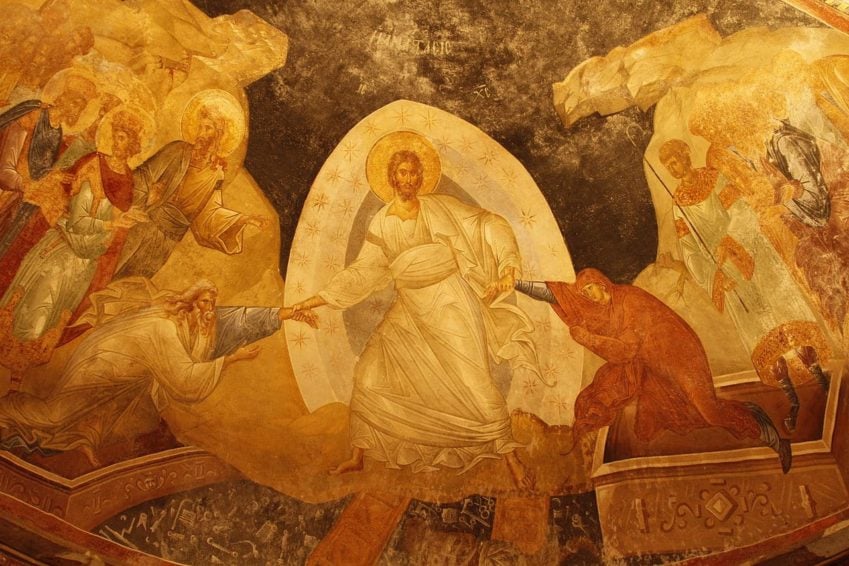
“Dear Father, when Christ died on the cross, St Matthew says that tombs were opened and people who had died were raised and went into the city and appeared to many. How are we meant to understand this? Did they really rise in their bodies and walk around again?”
The passage to which you refer says that when Christ breathed his last, “behold, the curtain of the temple was torn in two, from top to bottom; and the earth shook, and the rocks were split; the tombs also were opened, and many bodies of the saints who had fallen asleep were raised, and coming out of the tombs after his resurrection they went into the holy city and appeared to many” (Mt 27:51-53).
The Navarre Bible commentary says that this passage is not clarified by any other passages in Scripture, nor has there been any statement from the Magisterium, but that the great Church writers have proposed three possible explanations.
Three explanations
The first is that, rather than resurrections in the strict sense, they would have been apparitions of these deceased people.
This explanation, however, seems less faithful to the text, which uses the word “raised”, surrexerunt or “resurrected”, in Latin. This implies a true resurrection of the whole person, body and soul, not just an apparition.
The second is that these people would have risen from the dead in the strict sense, in their body and soul, as did Lazarus, and would have gone on to continue living until they died again.
The third is that their resurrection would have been definitive, or glorious, in the sense that they would not need to die again, in this way anticipating the final resurrection of the body.
This explanation, however, is difficult to reconcile with the clear affirmation of Scripture that Christ was the first-born from the dead (cf. 1 Cor 15:20; Col 1:18).
For these reasons writers like St Augustine, St Jerome and St Thomas Aquinas prefer the second explanation, because they consider that it fits best with the sacred text and it does not present the theological difficulties of the third explanation. It is also the solution proposed by the Catechism of the Council of Trent.
Perfect and imperfect resurrection
St Thomas deals with the question in his Summa Theologiae, III, q. 53, art 3, making reference to both St Augustine and St Jerome. He begins by quoting St Paul: “But in fact Christ has been raised from the dead, the first fruits of those who have fallen asleep” (1 Cor 15:20).
He goes on to distinguish two kinds of resurrection.
The first is what he calls imperfect resurrection, where a person is raised from the dead only to die again, like Lazarus.
The second is perfect resurrection, where the person is raised immortal and remains forever in life, like Christ himself, as in Romans 6:9: “Christ rising from the dead dies now no more.”
St Thomas concludes that if Christ was the first-born from the dead in a perfect resurrection, all those who were raised before him, including those who came out of the tombs after his death, had an imperfect resurrection. They rose in their bodies and lived on earth until they died again.
St Thomas says of these that “by an imperfect resurrection, some others have risen before Christ, so as to be a kind of figure of his resurrection”.
The Roman Catechism’s teaching
The Catechism of the Council of Trent, or Roman Catechism, echoes this teaching:
“These words of the Apostle are to be understood of a perfect resurrection, by which we are raised to an immortal life and are no longer subject to the necessity of dying. In this resurrection Christ the Lord holds the first place. For if we speak of resurrection, that is, of a return to life subject to the necessity of again dying, many were thus raised from the dead before Christ, all of whom, however, were restored to life to die again.”
“But Christ the Lord, having subdued and conquered death, so arose that he could die no more, according to this most clear testimony: ‘Christ rising again from the dead, dies now no more, death shall no more have dominion over him’” (Rom 6:9; Roman Catechism I, 5).
Do you have a question for Father Flader? Email [email protected]
Life after Death? What can we know?
Don’t miss out on a special Evening with the author on Friday 6 May featuring Fr Flader talking on his new book about life after death. Get in early and book now!
